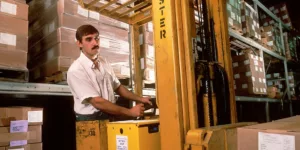Increased demand for products and goods has driven people and businesses to expand their production and storage capacities. As a result, the warehousing sector has seen significant growth in employment, with over 1.3 million employees working in the industry.
Experts predict that this number will reach 2 million by 2030. The warehousing industry is a relatively dangerous place to work. According to the Bureau of Labor Statistics, warehouse accidents accounted for eight percent of all the nonfatal injuries and illnesses reported in 2019.
Falling Objects, and Slips and Fall
Falling objects resulting from collapsing pallet racks are among the most prevalent warehouse accidents. These accidents are particularly dangerous if pallets are stacked improperly or are relatively high.
One way of minimizing falling object accidents is building steady racks by putting bulky items at the base and ensuring that items with cylindrical surfaces are stored and moved with the flat side facing down.
Slip, trip, and fall accidents are also pretty common in warehouses and are responsible for approximately 12 percent of all workplace accidents. These accidents are usually caused by oil and water spills or obstacles on the warehouse floor.
Warehouses can minimize slip and fall accidents by keeping the warehouse floor clean, dry, free of debris or potholes, and ensuring that warehouse workers are equipped with non-slip shoes.
Forklift Accidents and Overexertion Injuries
Another common accident in warehouses is forklift accidents. These accidents can be prevented by adequately training operators and ensuring that the forklifts are in their perfect working condition.
Other safety practices include:
- Maintaining reasonable speed.
- Keeping the headlights on in areas with low visibility.
- Carrying the recommended weight.
- Using the horn where needed.
Due to the nature of work in warehouses, injuries resulting from overexertion and repetitive movements such as strains and sprains, back pains, and other musculoskeletal illnesses are also pretty common.
OSHA Inspections
“An employer has a responsibility of keeping work environments safe for all employees and visitors,” says workers’ compensation attorney Felix Gonzalez. Additionally, the Occupational Safety and Health Administration (OSHA) is also responsible for conducting inspections of workplaces to ensure that employers comply with the set rules.
OSHA prioritizes several safety aspects when conducting the inspections, which include:
- Situations that indicate imminent danger
- Reported severe injuries or illnesses
- Workers’ complains
- Targeted inspections
- Follow up inspections
As a federal government agency tasked with ensuring workers’ safety, OSHA inspections must follow a standard procedure that includes various steps.
In the first step, OSHA officials research a business’s safety compliance based on information provided in the complaint. After research, the next phase is the inspection which starts with an OSHA official debriefing a warehouse manager or business owner on the reason for their inspection and what it will entail.
The inspector then performs a walkthrough to examine the safety standards in the facility with the help of a workers’ union representative. After the walkthrough, the inspector holds a closing conference with the business owner and a workers’ representative. They disclose their findings, what they mean for the business, suggest an improvement, and maybe schedule a follow-up inspection in the future.








